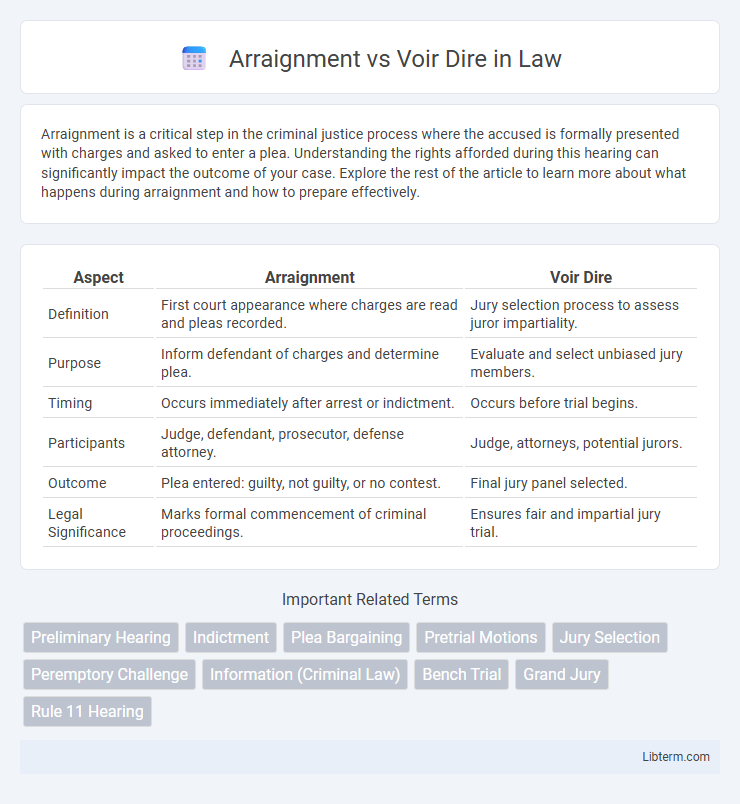Arraignment is a critical step in the criminal justice process where the accused is formally presented with charges and asked to enter a plea. Understanding the rights afforded during this hearing can significantly impact the outcome of your case. Explore the rest of the article to learn more about what happens during arraignment and how to prepare effectively.
Table of Comparison
| Aspect | Arraignment | Voir Dire |
|---|---|---|
| Definition | First court appearance where charges are read and pleas recorded. | Jury selection process to assess juror impartiality. |
| Purpose | Inform defendant of charges and determine plea. | Evaluate and select unbiased jury members. |
| Timing | Occurs immediately after arrest or indictment. | Occurs before trial begins. |
| Participants | Judge, defendant, prosecutor, defense attorney. | Judge, attorneys, potential jurors. |
| Outcome | Plea entered: guilty, not guilty, or no contest. | Final jury panel selected. |
| Legal Significance | Marks formal commencement of criminal proceedings. | Ensures fair and impartial jury trial. |
Understanding Arraignment: Definition and Purpose
Arraignment is a critical stage in the criminal justice process where the accused is formally charged and informed of their rights, including the right to counsel and the right to enter a plea. The purpose of arraignment is to ensure that defendants understand the nature of the charges against them and to establish the official record in the case. This proceeding sets the foundation for the trial by confirming the defendant's identity, outlining the charges, and determining bail or detention status.
What Happens During an Arraignment?
During an arraignment, the defendant is formally presented with the charges filed against them and informed of their legal rights, including the right to an attorney. The court typically asks the defendant to enter a plea of guilty, not guilty, or no contest. This hearing sets the stage for future proceedings by establishing the official court record and scheduling subsequent dates such as preliminary hearings or trials.
Exploring Voir Dire: Meaning and Significance
Voir dire is a critical pre-trial process in which attorneys and judges question potential jurors to determine their suitability, impartiality, and possible biases. This procedure ensures the selection of a fair and unbiased jury, which directly impacts the trial's fairness and outcome. By carefully examining jurors' backgrounds and beliefs during voir dire, the court aims to uphold the defendant's right to an impartial trial under the Sixth Amendment.
The Voir Dire Process in Court
The voir dire process in court involves the selective questioning of potential jurors to assess their qualifications, biases, and ability to deliver a fair verdict. Attorneys and judges examine jurors' backgrounds, beliefs, and any prior experiences that could influence case impartiality. This critical step ensures an unbiased jury, safeguarding the defendant's right to a fair trial and upholding the integrity of the judicial system.
Key Differences Between Arraignment and Voir Dire
Arraignment is the initial court proceeding where the defendant is formally charged and enters a plea, establishing the foundation of the criminal case. Voir dire, on the other hand, is the jury selection process aimed at screening potential jurors for impartiality before trial commences. The key differences lie in arraignment addressing the defendant's charges and plea, while voir dire focuses on ensuring a fair and unbiased jury panel.
Roles of Defendants in Arraignment vs. Voir Dire
Defendants in arraignment are formally presented with charges and asked to enter a plea, establishing the foundation for the trial process. During voir dire, defendants' roles involve participating in jury selection, where potential jurors are questioned to ensure an impartial jury. These distinct stages highlight defendants' active engagement in both responding to accusations and shaping the jury composition.
Legal Rights at Arraignment and Voir Dire
Arraignment is the initial court procedure where defendants are informed of their legal rights, including the right to legal counsel, the right to remain silent, and the right to a fair trial. Voir dire focuses on the selection of an impartial jury, ensuring potential jurors possess no biases that could affect legal rights to an unbiased trial. Both processes play critical roles in safeguarding defendants' constitutional rights, with arraignment establishing foundational protections and voir dire promoting juror impartiality.
Timeline: When Do Arraignment and Voir Dire Occur?
Arraignment occurs early in the criminal justice process, typically within 48 hours after an arrest, where the defendant is formally charged and enters a plea. Voir dire follows later, taking place before the trial begins, during jury selection to assess potential jurors' impartiality and suitability. This timeline distinction is critical, with arraignment setting the stage for trial and voir dire ensuring a fair jury panel.
Common Misconceptions About Arraignment and Voir Dire
Arraignment is often misunderstood as a trial stage, but it primarily involves formally presenting charges and entering a plea, whereas voir dire is the jury selection process aimed at screening for impartial jurors. Many mistakenly believe voir dire determines guilt or innocence, but its purpose is to ensure a fair trial by identifying biases among potential jurors. Understanding these distinctions is crucial for grasping the procedural flow within the criminal justice system.
Importance of Both Arraignment and Voir Dire in the Justice System
Arraignment establishes the formal charges against a defendant, ensuring their right to be informed and to enter a plea, which is crucial for procedural fairness in the justice system. Voir dire plays a critical role in selecting an impartial jury by questioning potential jurors to identify biases, thereby safeguarding the defendant's right to a fair trial. Together, arraignment and voir dire uphold foundational legal protections, maintaining the integrity and fairness of criminal proceedings.
Arraignment Infographic

 libterm.com
libterm.com